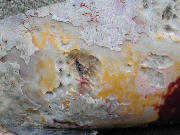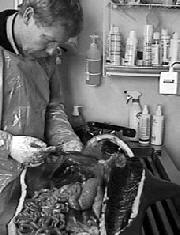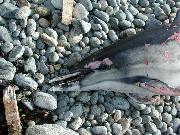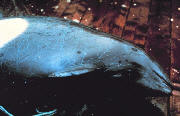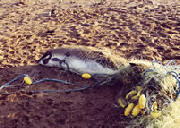EUROPEAN CETACEAN BYCATCH CAMPAIGN
"Man is but a strand in the complex web of life"
"Man is but a strand in the complex web of life"
January - May 2001 : there was a significant increase in the number of dolphins stranding on the coasts of Cornwall, Devon, Jersey, Guernsey, and France.
Many of the bodies displayed puncture wounds, which were probably made by fishermen in an attempt to make the bodies sink.
January - April 2002 : in excess of 1000 dolphins, the vast majority being common dolphins, were found on the beaches of southern England and western France.
There was also a substantial increase in the number of bycaught harbour porpoises, pilot and minke whales.
It is now accepted that these fatalities were as a result of pair trawling activities in the Western Approaches. Scientists have suggested that 4000 –10000 dolphins may have died.
Of the stranded cetaceans post mortemed by veterinary surgeons at the Institute of Zoology in London 1990 - 1997,
34.4% of harbour porpoises were found to be bycatch
60.4% of common dolphins were found to be bycatch
11.6% of other whales and dolphins were found to be bycatch.
39.8% of all cetaceans were found to be bycatch.
(These figures are likely to be an underestimate, as a cause of death could not be established for nearly a quarter of all those post mortemed).
Of the stranded cetaceans post mortemed by veterinary surgeons at SAC Veterinary Science
Division, Inverness, 1995 - 1999,
15.4% of harbour porpoises were found to be bycatch
11.7% of white-sided dolphins were found to be bycatch
16.7% of bottlenose dolphins were found to be bycatch
(caught in illegally set nets)
40.0% of Risso's dolphins were found to be bycatch
40.0% of minke whales died as a result of entanglement in fixed ropes, such as creel or mooring ropes.
Many of the bodies displayed puncture wounds, which were probably made by fishermen in an attempt to make the bodies sink.
January -
There was also a substantial increase in the number of bycaught harbour porpoises, pilot and minke whales.
It is now accepted that these fatalities were as a result of pair trawling activities in the Western Approaches. Scientists have suggested that 4000 –10000 dolphins may have died.
Of the stranded cetaceans post mortemed by veterinary surgeons at the Institute of Zoology in London 1990 -
34.4% of harbour porpoises were found to be bycatch
60.4% of common dolphins were found to be bycatch
11.6% of other whales and dolphins were found to be bycatch.
39.8% of all cetaceans were found to be bycatch.
(These figures are likely to be an underestimate, as a cause of death could not be established for nearly a quarter of all those post mortemed).
Of the stranded cetaceans post mortemed by veterinary surgeons at SAC Veterinary Science
Division, Inverness, 1995 -
15.4% of harbour porpoises were found to be bycatch
11.7% of white-
16.7% of bottlenose dolphins were found to be bycatch
(caught in illegally set nets)
40.0% of Risso's dolphins were found to be bycatch
40.0% of minke whales died as a result of entanglement in fixed ropes, such as creel or mooring ropes.
The report for Contract CR0177, conducted for the Department of the Environment, Transport and the Regions, by the Institute of Zoology (Zoological Society of London), clearly shows that for the period 1990-1999, the bycatch percentage of common dolphins in Cornwall and Devon, where a cause of death was established, was 86%.
The vast majority of these common dolphin strandings in Cornwall and Devon occurred during the period November – April, which coincides with trawling activity, including pair trawling in the Western Approaches.
The physical evidence of entanglement in fishing nets or gear is:
Gill nets, trammel nets, and tangle nets: lacerations on the head, body, fins and tail fluke caused by the net; penetrating wounds, often in the lower jaw and head area, made by gaffs, or fire axes used by fishermen to remove the cetaceans from the net; broken bones; broken teeth; internal haemorrhage and signs of asphyxiation.
Drift nets: lacerations on the head, body, fins and tail fluke caused by the net; bite marks on all parts of the body caused by scavengers such as sharks; severed flukes, fins, and tails caused by fishermen using gaffs, or fire axes to remove the cetaceans from the nets: internal injuries and signs of asphyxiation.
Trawl nets and gear: deep wounds to the head and body; severed beaks, fins, and tails caused by fishermen using gaffs, or fire axes to remove the cetaceans from the nets; severe internal injuries including crushed organs; puncture wounds made by fishermen so that the body will sink and a quite recent development, beheading the animal, when it has become stuck in the intake of a fish pump and blocked it.
Anecdotal evidence from fishermen suggest, and post-
If an ordinary individual carried out such acts, the legislative procedure would ensure that the individual was punished.
However, the fishing industry appears to be above the law.
The problem of cetacean bycatch is not a hopeless one. There are measures that can be taken to significantly reduce the number of needless deaths. Efforts to address bycatch problems in other countries, e.g.. USA and New Zealand, are underpinned by targeted legislation and a legal framework of wide-
In 1994, it was estimated that 2100 harbour porpoises were killed in the Gulf of Maine gillnet fisheries each year. In January 1999, a TRP was put into effect. The deaths of harbour porpoises were reduced to 270.
Top
